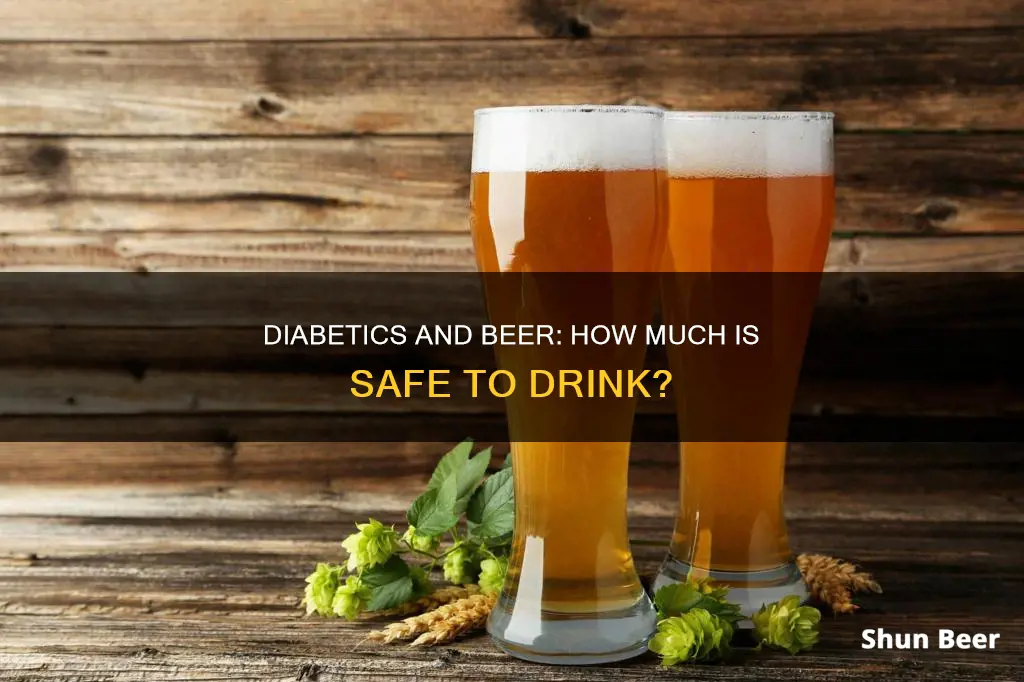
People with diabetes can drink alcohol, including beer, in moderation. However, it is important to note that alcohol can impact blood sugar levels, increase appetite, and reduce the effectiveness of diabetes medications. The recommended amount is no more than two drinks per day for men and no more than one drink per day for women. When it comes to beer, one drink is typically considered to be 12 ounces or one can or bottle. Beer is usually higher in carbohydrates compared to other alcoholic drinks, but the carb and calorie content can vary depending on the type of beer. Light beers tend to have fewer carbs and calories, while craft beers like IPAs and stouts tend to have more. It is also important to drink in moderation, eat a source of carbohydrates while drinking, and monitor blood sugar levels before, during, and after drinking.
| Characteristics | Values |
|---|---|
| Alcohol consumption recommendations for diabetics | No more than one drink a day for women and up to two drinks a day for men. |
| "Binge drinking" | Drinking more than four drinks (for women) or five drinks (for men) within two hours, is strongly discouraged for health and safety reasons. |
| One drink | 12 ounces, or one can or bottle of beer. |
| Light beers | Lowest in carbs, calories, and alcohol. |
| Beer alternatives for diabetics | Red wine, dry white wine, distilled spirits such as gin, tequila, vodka, or whiskey, and low-carb cocktails. |
What You'll Learn

Diabetics should drink beer in moderation
Diabetes is a condition that affects the body's ability to regulate blood sugar, and it can be dangerous if blood sugar levels drop too low, a state known as hypoglycemia. Beer, like other alcoholic drinks, can affect blood sugar levels, so diabetics need to be cautious when consuming it. However, this does not mean that diabetics need to abstain from drinking beer entirely. In fact, moderate consumption of beer may even have some benefits for diabetics.
Firstly, it is important to understand what constitutes moderate drinking. For women, it is generally recommended to have no more than one drink per day, and for men, no more than two drinks per day. A drink is typically defined as 12 fluid ounces of regular beer (5% alcohol). It is also important to note that the alcohol content of beer can vary, so it is always good to check the label.
For diabetics, drinking beer in moderation is key. Excessive alcohol consumption can increase the risk of hypoglycemia, as alcohol interferes with the liver's ability to regulate blood sugar. Therefore, diabetics should avoid drinking on an empty stomach and should always have food, especially carbohydrate-rich foods, when consuming beer. Additionally, it is important to monitor blood sugar levels before, during, and after drinking, as alcohol can affect blood sugar levels for up to 24 hours after consumption.
When it comes to the type of beer, light beers are a better option for diabetics as they have fewer calories and carbohydrates than regular beers. Non-alcoholic beers, on the other hand, have similar carb content to regular beers but with fewer calories. It is also worth noting that beer bottles and cans often do not have nutrition labels, so checking the manufacturer's website or nutrition websites can be helpful.
In conclusion, while diabetics need to be cautious, they can still enjoy beer in moderation. By following guidelines for moderate drinking, consuming beer with food, and monitoring blood sugar levels, diabetics can reduce the risk of hypoglycemia and safely include beer in their diet.
Beer and Tramadol: A Risky Mix?
You may want to see also

Beer is higher in carbs than wine or liquor
Beer is typically higher in carbs than wine or liquor. The number of carbs in beer varies widely depending on the type, with light beers containing the least amount of carbs, usually 5 grams or less per serving, and craft beers like IPAs and stouts containing the most, with 15 grams or more per serving. Beer is made from grains and is significantly higher in carbs than wine because the yeast is unable to ferment all the carbs in the beer. A 425ml schooner of beer contains 6-18 grams of carbs, while a 150ml glass of dry red or white wine contains only 0.5-2 grams of carbs. Spirits are also pretty much carb-free until they are mixed with something else.
Beer is usually served in higher volumes than wine. While a glass of wine is around 150ml, beer is usually served in schooners or pints which are 425ml and 570ml respectively. This means that, despite wine tending to be higher in alcohol content than beer, the calorie difference from alcohol content isn't that different between the two. A 150ml glass of wine has 80-140 calories from alcohol, and a 425ml schooner of beer has 80-140 alcohol calories.
If you are watching your carb intake, it is better to opt for a low-carb beer or dry wine as your drink of choice. Light beers are the lowest in carbs, calories, and alcohol content. However, if you are drinking beer, it is important to pace yourself and stick to no more than one drink per hour and no more than three or four drinks in a day.
It is important to note that drinking guidelines for people with diabetes are the same as for the general population: no more than one drink per day for women and up to two drinks per day for men. It is also important to drink in moderation, eat while drinking, and keep an eye on your blood sugar levels.
Tooth Extraction and Beer: What You Need to Know
You may want to see also

Light beers have fewer carbs and calories
Light beers have the least carbs, typically 5 grams or fewer per serving. They are also lower in alcohol content. So, if you're planning on having more than one beer, light beers are your best option.
Light beers are brewed with distinct enzymes that break down carbohydrates into alcohol instead of allowing them to remain as starch. This means that light beers have fewer carbs and calories than regular beers. However, it's important to note that the definition of "light" beer varies among brands. Sometimes it means the beer contains less alcohol, sometimes it means fewer calories, and sometimes both.
Examples of light beers
- Budweiser Select 55: 55 calories, 1.9g carbs, 2.4% ABV
- Corona Premier: 90 calories, 2.6g carbs, 4% ABV
- Miller Lite: 96 calories, 3.2g carbs, 4.2% ABV
- Beck's Premier Light: 64 calories, 3.9g carbs, 2.3% ABV
- Michelob Ultra Pure Gold: 85 calories, 2.5g carbs, 3.8% ABV
- Amstel Light: 95 calories, 5g carbs, 3.5% ABV
- Yuengling Flight: 95 calories, less than 3g carbs, 4.2% ABV
- Milwaukee's Best Light: 96 calories, 3.5g carbs, 4.2% ABV
- Yuengling Light Lager 99: 99 calories, 3.2g carbs, 4.2% ABV
Tips for drinking beer as a diabetic
If you have diabetes, you don't need to cut alcohol out of your diet completely. In fact, light drinking (no more than one to two drinks a day) may be beneficial for diabetes. However, there are some important safety considerations to keep in mind:
- Alcohol competes with your liver's ability to make glucose when your blood sugar is low. If you are on insulin or other anti-hyperglycemic medications, this can lead to dangerously low blood sugar levels up to 24 hours after drinking.
- Alcohol can cloud your judgment, so you may not realise that your blood sugar is low.
- To prevent hypoglycemia, don't drink on an empty stomach. Make sure you have food while drinking and keep an eye on your blood sugar.
- Drink in moderation and stay hydrated!
Mixing Beer and Whiskey: A Safe Drinking Guide
You may want to see also

Alcohol affects the liver's ability to regulate blood sugar
Alcohol can affect the liver's ability to regulate blood sugar in several ways. Firstly, the liver is responsible for detoxifying the body by breaking down toxins like alcohol. When alcohol is present in the body, the liver prioritises metabolising it, which can interfere with its ability to release sufficient glucose into the bloodstream, leading to low blood sugar or hypoglycaemia. This is especially true when drinking on an empty stomach, as the liver has to work harder to break down the alcohol without the support of food. Additionally, alcohol inhibits the liver's ability to produce glycogen, which is stored in the form of glucose. This can further contribute to low blood sugar levels.
The effects of alcohol on blood sugar are twofold. Initially, alcohol can cause blood glucose levels to spike as the sugar from the alcohol enters the bloodstream. However, once the body has absorbed all the sugar it can from the alcohol, blood sugar levels will start to decrease. This is because alcohol impairs liver function, preventing it from releasing enough glycogen to maintain healthy blood glucose levels. This decrease in blood sugar can last for several hours after drinking, and can be particularly dangerous for people with diabetes who take insulin or medications that increase insulin production, as it can lead to insulin shock, a medical emergency.
Therefore, it is important for people with diabetes to be cautious when consuming alcohol. It is recommended that they do not drink on an empty stomach, limit their alcohol intake, drink at a slow or moderate pace, and regularly monitor their blood sugar levels while drinking and in the hours afterwards. Consulting with a doctor is also advisable, as they can provide personalised advice and tips for drinking safely.
Beer and Aspirin: Safe Mix or Health Risk?
You may want to see also

Alcohol may reduce medication effectiveness
Alcohol may reduce the effectiveness of diabetes medications. This is because the liver, which is responsible for metabolising alcohol and releasing glucose, will prioritise breaking down alcohol over maintaining blood glucose levels. This can lead to hypoglycaemia, where blood sugar levels drop dangerously low. The risk of hypoglycaemia is multiplied with each additional drink consumed, and can be lowered by consuming alcohol with food.
Alcohol can also affect your body's ability to regulate blood sugar. It can make it drop, especially if you haven't eaten enough. If you've had a big meal and a lot of alcohol, it can also raise your levels too high. It is important to keep blood glucose levels stable, as when they drop below 70 milligrams/deciliter, they can cause headaches, irregular heartbeat, anxiety, and confusion. If levels are low enough, it may even cause seizures.
If you are taking insulin or other anti-hyperglycemic medications, alcohol can lead to dangerously low blood sugar up to 24 hours after you stop drinking. Alcohol can also cloud your judgement, so you may not realise that your blood sugar is low. Therefore, it is important to monitor your blood sugar levels before, during, and after drinking, and to keep a source of carbohydrates, such as glucose tablets, with you when drinking.
Certain diabetes medications, such as sulfonylureas and thiazolidinediones, can increase the risk of hypoglycaemia. It is important to talk to your doctor about whether and how you can safely consume alcohol while taking these medications.
Beer and Crestor: Is One Drink Okay Daily?
You may want to see also
Frequently asked questions
Yes, diabetics can drink beer, but it is recommended to do so in moderation.
It is recommended that men with diabetes do not exceed two drinks per day.
It is recommended that women with diabetes limit themselves to one drink per day.
One drink of beer is typically defined as 12 fluid ounces or 360 milliliters.
Diabetics should avoid drinking beer on an empty stomach as it can cause hypoglycemia (low blood sugar). It is recommended to consume food, especially carbohydrates, along with beer. Monitoring blood sugar levels before, during, and after drinking is also important.







